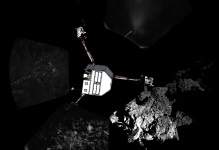

After detaching itself from the Rosetta Orbiter space craft the Philae Lander drifted 14 miles down and touched down on primary landing site Agilkia, bringing a journey that has lasted for more than a decade and cost EUR 1.4 billion to an end. Shortly after it landed, it began to transmit data back to the project team at the European Space Centre. Since then, it has confirmed the presence of carbon containing organic minerals through an electronic contraption designed to sniff the atmosphere.
For the mining industry, the momentous achievement of the Rosetta mission serves to add substance to the pioneering ambitions of the companies aiming to take mineral extraction to outer space. Speaking to Bloomberg shortly after the landing had been confirmed, a visibly excited Chris Lewicki, president and chief executive at Planetary Resources, said: "This is the first time in history that we’ve had something that was designed to go down to the surface of one of these small bodies of comets and asteroids and really study its surface." He added: "We’ve seen it in the movies for a very long time, but today we’re actually seeing the real thing."
For Planetary Resources and competitor Deep Space Industries, the success of the Rosetta mission marks a major step forward in turning deep space mining into a reality. Both companies have outlined ambitious targets of prospecting materials such as platinum within the next decade. Planetary Resources envisages the potential resources to be significant enough to make it viable to bring the materials back and sell for use on Earth, while Deep Space Industries is more focused on establishing an operation to supply commodities to ships and satellites for use in space.
Mining targets "far easier" to reach than Rosetta
In an interview with the Boston Globe following the Rosetta landing, David Gump, vice chairman of Deep Space Industries, said that reaching near Earth asteroids (NEAs) would be "far easier" than a mission like Rosetta. The company plans to extract materials from asteroids and store them on a geosynchronous satellite with a view to selling them on to other space craft. The aim is to offer craft an alternative to returning to earth in order to refuel or restock supplies. "Right now it costs $17 million per ton to get anything up to geosynchronous orbit. If we can beat whatever that price is in 2022, we’ll have a big market," said Gump.
Deep Space Industries has joined the mission to mine metals from space, but who will get there first?
Planetary Resources on the other hand, believes that the amount of valuable elements that available in space would make it economically viable to transport it back to Earth and sell into industry. It suggests that a 500 meter wide asteroid with rich platinum deposits could contain 1.5 times the total amount present on Earth. Eric Anderson, CEO at Platinum Resources, explained that despite the high cost and challenges of mining near earth objects, the prospect is economically attractive considering platinum currently trades at more than $1000 per ounce. "We could bring platinum back at cost of $300 per ounce and that could go way down over time," he said.
Asteroid assessment set for 2015
The company suffered a setback in October when its Arkyd-3 satellite was destroyed on board the Antares resupply rocket, which exploded shortly after takeoff. The intention of the mission was to launch the spacecraft from the International Space Station and conduct tests and analysis of the near earth space environment. Despite its destruction, Planetary Resources claims to still be on schedule and will launch an improved model, the Arkyd-6, in the summer of 2015. The next model is expected to feature a telescope that will enable it to inspect asteroids in order to assess the resource potential.
Both Deep Space Industries and Planetary Resources are a long way off extracting precious materials from asteroids and must overcome significant hurdles, particularly with regards to developing the machinery and technology that will carry out the mining. However, the successful landing of the Philae probe onto the surface of the comet has proven that such bodies are within reach. That proof of concept will be a valuable tool in securing further investment to achieve their aims, so the days of mining being restricted to within Earth’s atmosphere may well be numbered.


.gif)

